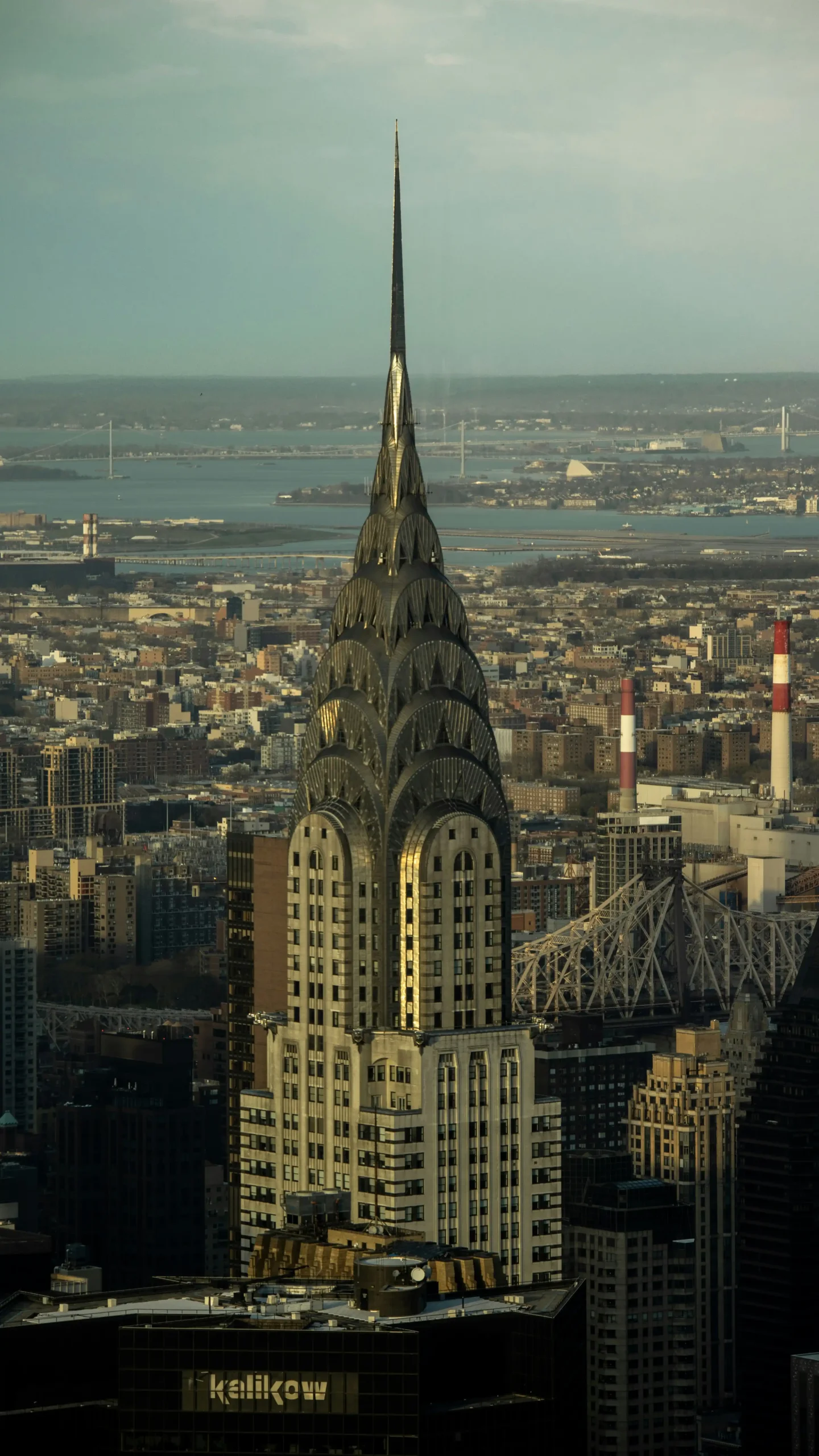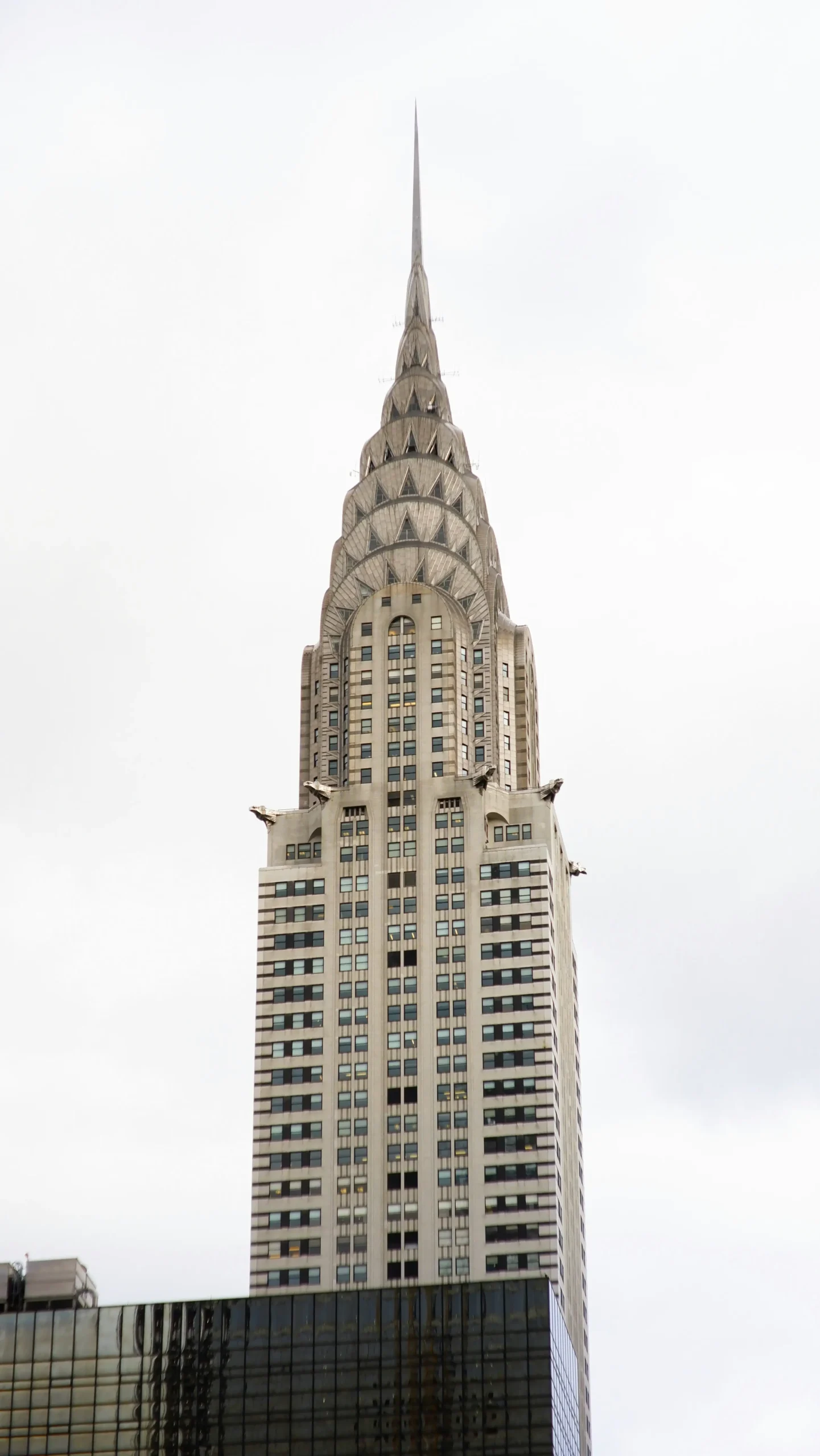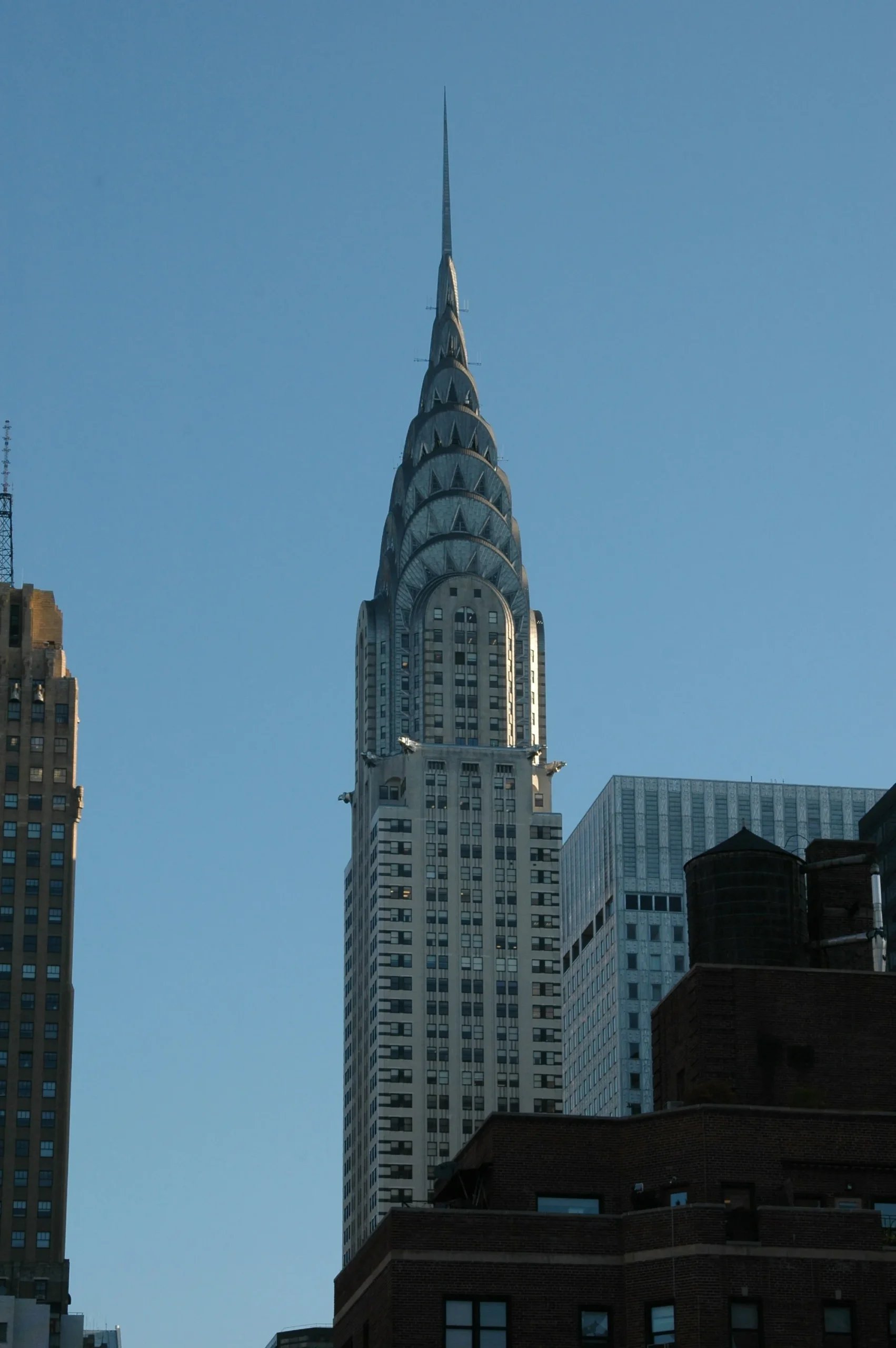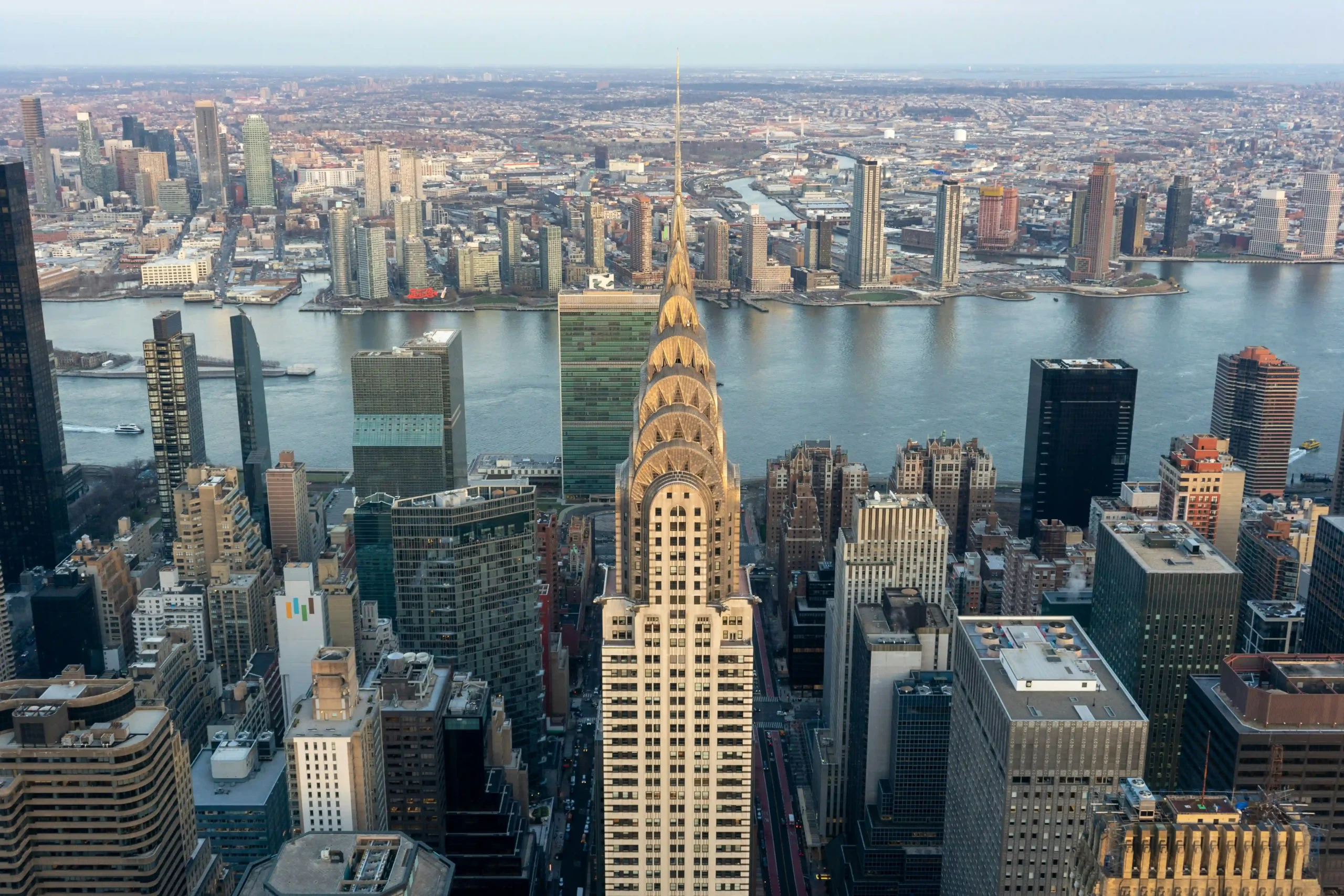The Chrysler Building has stood as a gleaming jewel of the New York City skyline since its completion in 1930. Known for its dazzling Art Deco spire and ornamentation inspired by the automobile age, the building has long been considered a masterpiece of early 20th-century architecture. Though it briefly held the title of the world’s tallest building, the Chrysler Building’s influence extends far beyond its height, representing an era of elegance, craftsmanship, and the race for the skies that defined the pre-Depression boom.
The Chrysler Building was designed by architect William Van Alen for automobile magnate Walter P. Chrysler, who personally financed the project as both a symbol of the Chrysler Corporation’s prominence and a lasting legacy in his name. Rising at a remarkable pace, the skyscraper was completed in just under three years during a fierce competition to construct the world’s tallest building. To outdo the nearby 40 Wall Street (now known as The Trump Building), which was also vying for the record, Van Alen executed a bold, secretive plan: a 185-foot spire was assembled inside the building and dramatically raised into place at the last moment. This final addition brought the Chrysler Building’s height to 1,046 feet, earning it the title of the world’s tallest structure upon completion in 1930. Though its reign lasted less than a year—overtaken by the Empire State Building—the Chrysler Building remains one of the most iconic and admired skyscrapers ever built.
Tower Stats
- Height (to tip): 1046 ft / 319 m
- Roof height: 925 ft / 282 m
- Floors: 77
- Observation decks: None currently open to the public
- Construction period: 1928 – May 1930
- Architect: William Van Alen
- Design style: Art Deco
- Structural material: Steel frame with stainless steel and masonry cladding
- Elevators: 32 (modernized over time)
- Floor area: Approx. 1.2 million sq ft (111,000 m²)
- Official opening: May 27, 1930
Engineering and Design
At the time of its construction, the Chrysler Building pushed the boundaries of skyscraper engineering and aesthetics. Its steel frame allowed for rapid vertical construction and dramatic ornamentation. The exterior features brick and terra-cotta cladding, but it is most famous for its crown: a tiered, radiating stainless-steel spire adorned with triangular windows that shimmer in sunlight and glow when illuminated at night.
The Chrysler Building’s design is rich with automobile-inspired elements, including stainless-steel eagle ornaments on the 61st floor modelled after 1929 Chrysler hood ornaments. Its iconic spire—secretly assembled inside the tower and raised into place—gave the building the height needed to briefly surpass its rivals as the tallest in the world. Today, the Chrysler Building’s Art Deco style remains one of the most celebrated and studied examples of the genre.
Interior and Public Access
Unlike many other skyscrapers of its stature, the Chrysler Building does not currently have a public observation deck. However, its lobby remains open to visitors and is a stunning showcase of Art Deco interior design. Featuring polished African marble walls, a mural-covered ceiling, and intricate decorative patterns, the lobby has been preserved as a historic landmark.
In 2020, plans were proposed to open a new observation deck on the 61st floor, potentially giving the public access to sweeping views of Manhattan from within one of the city’s most iconic towers. As of 2025, these plans have not been fully realized, but discussions continue. Until then, visitors can admire the building from street level and the lobby, which continues to impress tourists and architecture lovers alike.



Thank you, Photographers! Ulrike R. Donohue, Nicole Padin, Michael van Gorkum, andJason Krieger on Unsplash
Tenants and Commercial Use
The Chrysler Building has housed a wide variety of tenants throughout its history, including law firms, real estate companies, and design studios. It remains a commercial office building with dozens of businesses operating across its 77 floors. Though it has changed ownership several times in recent decades, the building continues to command prestige as an office address, despite newer, taller towers rising all around Midtown Manhattan.
In 2019, the building was sold for $150 million to new owners, who have since undertaken modest renovations aimed at revitalizing both its infrastructure and tenant spaces. While its size and age may limit its appeal to some modern firms, its symbolic status and breathtaking architecture continue to attract interest.
Renovations and Preservation
Over the years, the Chrysler Building has undergone preservation-focused renovations to maintain its historic details while upgrading essential systems. Although it has not received sustainability certifications like some newer buildings, conservation efforts have helped protect its exterior and interior heritage.
Work has included the cleaning and repair of the stainless-steel crown, modernization of elevators and HVAC systems, and restoration of the lobby’s intricate finishes. The building is a designated New York City Landmark (designated in 1978) and is listed on the National Register of Historic Places (since 1976), ensuring that its architectural legacy will be protected for generations to come.
Fun Facts
The Chrysler Building was the first man-made structure to surpass 1,000 feet in height:
Completed in 1930, its spire reached 1,046 feet (319 meters), making it the first structure in the world to exceed the 1,000-foot mark.
At the time of its completion, the Chrysler Building was taller than the Eiffel Tower and became the tallest man-made structure in the world:
The Eiffel Tower, completed in 1889, stood at 984 feet (300 meters) until 1957, when a television antenna was added, increasing its height by 61 feet (18.7 meters). Further antenna upgrades in 2000 and 2022 brought it to its current height of 1,083 feet (330 meters), once again making it taller than the Chrysler Building. Despite this, the Eiffel Tower is still not considered a building, as it lacks fully habitable floors.
Eagle gargoyles on the 61st floor resemble hood ornaments from 1929 Chrysler automobiles:
These iconic Art Deco sculptures are directly inspired by Chrysler radiator caps, highlighting the brand’s influence on the building’s design.
The building contains some of the few remaining Art Deco elevator cabs in New York City:
The elevators retain their original wood marquetry, chrome accents, and geometric motifs, making them rare surviving examples of authentic Art Deco interiors.
It was the tallest building in the world for only 11 months before the Empire State Building overtook it:
The Empire State Building was completed in May 1931, just 11 months after the Chrysler Building claimed the world title.
The building’s lobby is adorned with an enormous ceiling mural titled “Transport and Human Endeavor”:
Painted by Edward Trumbull, the mural spans the entire lobby ceiling and celebrates aviation, industry, and human progress.
It is often voted one of the most beloved buildings in America by architecture organizations, including the American Institute of Architects:
The AIA has ranked it among the most admired American buildings, and it frequently tops polls as the public’s favourite skyscraper.
Cultural Legacy
From its glittering spire to its automobile-inspired flourishes, the Chrysler Building has long been a symbol of New York City’s creative and industrial spirit. Though no longer the tallest, it remains one of the most admired skyscrapers in the world. Its presence in popular culture is widespread, appearing in everything from classic noir films and comic books to contemporary movies and TV shows.
A timeless symbol of the Art Deco era, the Chrysler Building is widely considered an architectural jewel. It represents not just an ambitious period of construction, but a cultural moment when craftsmanship, competition, and artistic vision reached new heights. Nearly a century later, it continues to evoke wonder, pride, and a touch of nostalgia in all who look upon it.
The Chrysler Building may not dominate the skyline in height anymore, but in elegance and cultural importance, it remains peerless—a permanent fixture in the story of New York and the history of the skyscraper.

